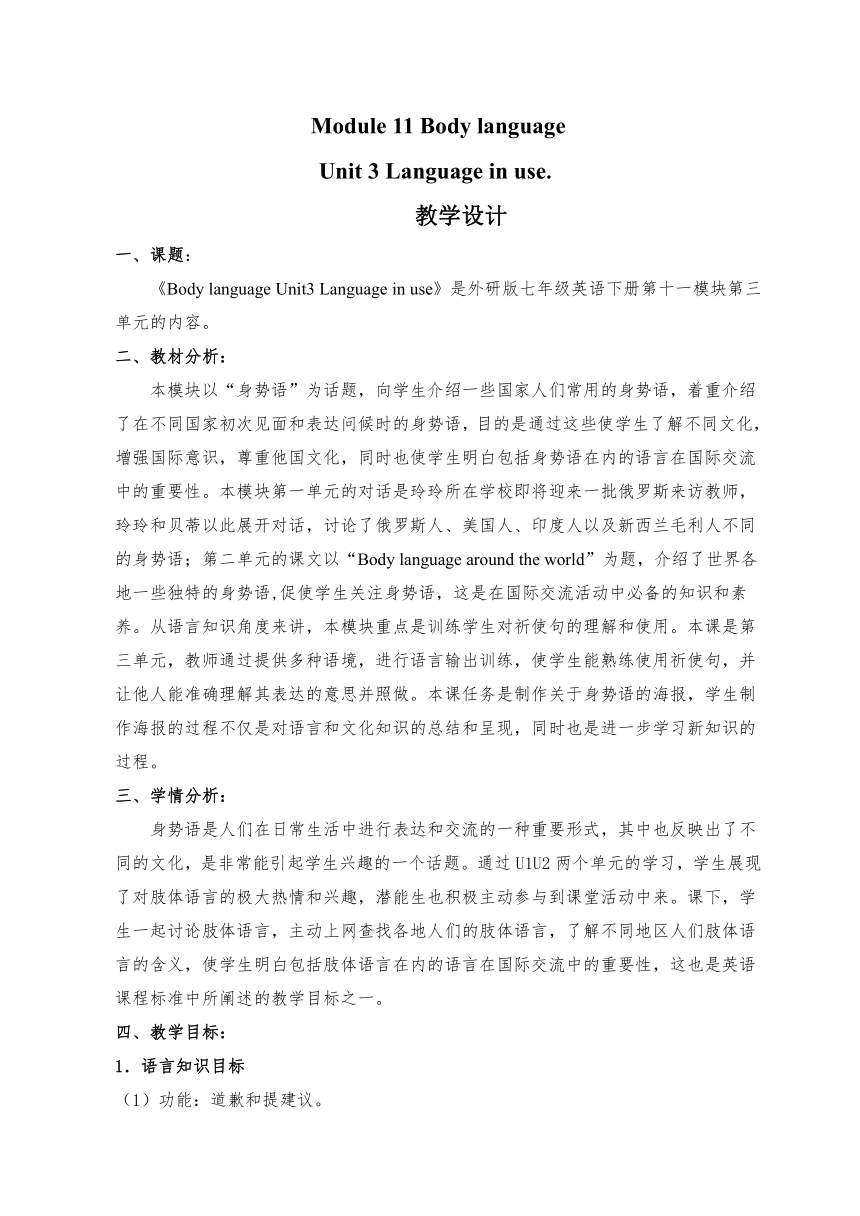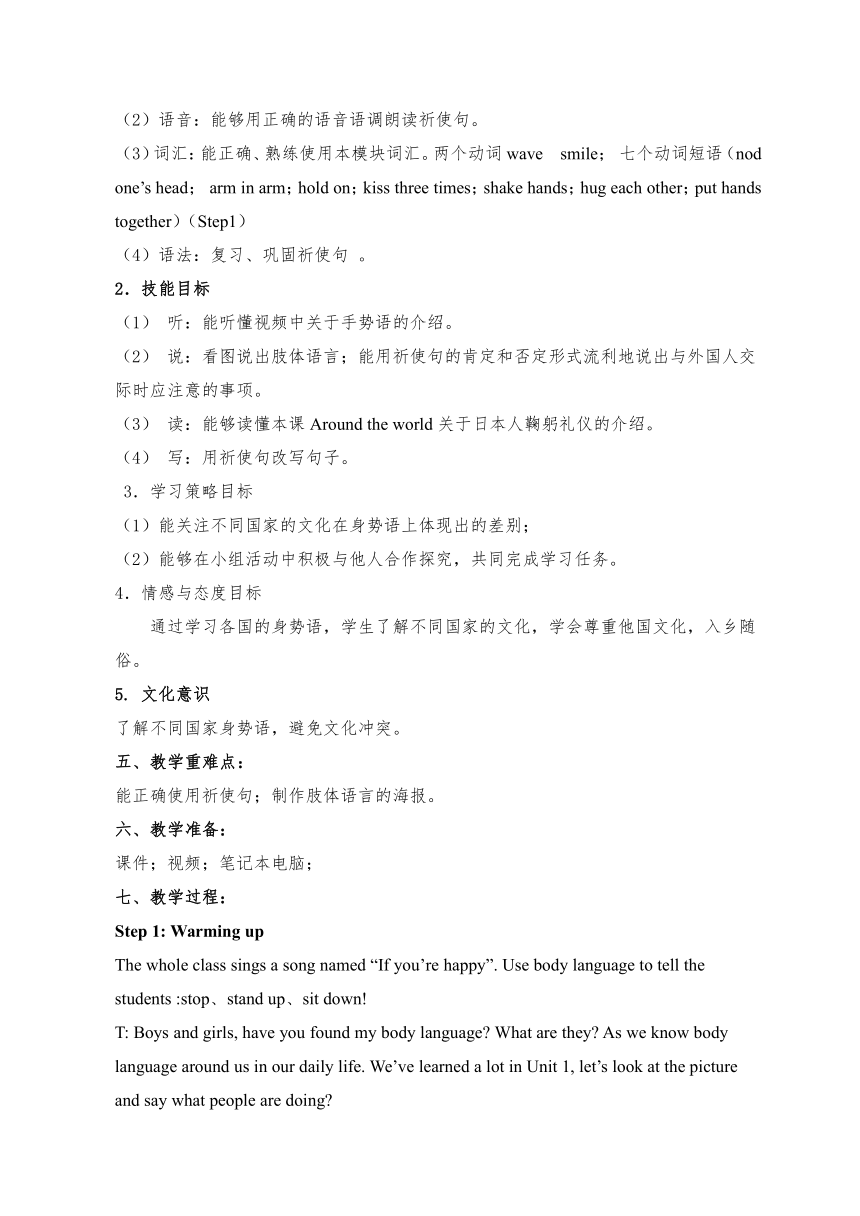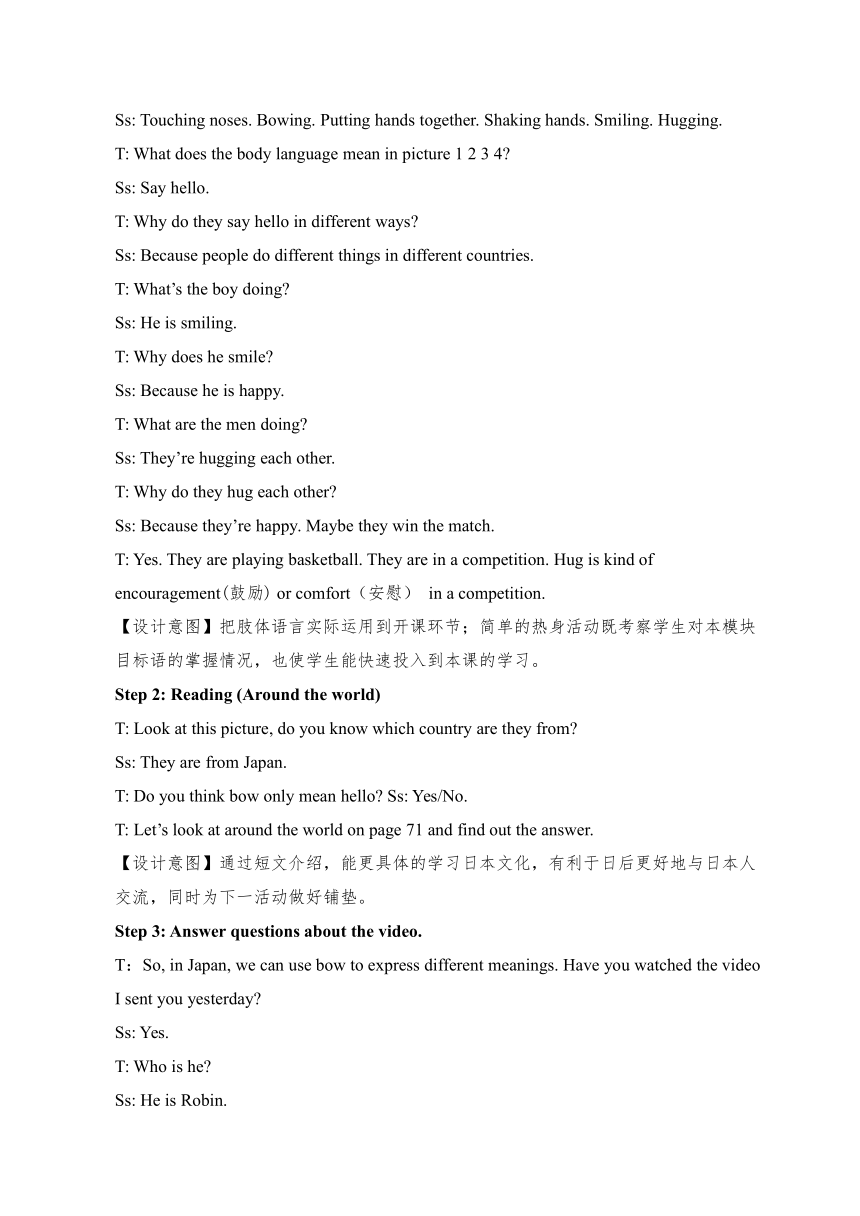Module 11 Unit 3 Language in use 教案
文档属性
| 名称 | Module 11 Unit 3 Language in use 教案 |  | |
| 格式 | doc | ||
| 文件大小 | 81.0KB | ||
| 资源类型 | 教案 | ||
| 版本资源 | 外研版 | ||
| 科目 | 英语 | ||
| 更新时间 | 2022-05-25 23:23:10 | ||
图片预览



文档简介
Module 11 Body language
Unit 3 Language in use.
教学设计
一、课题:
《Body language Unit3 Language in use》是外研版七年级英语下册第十一模块第三单元的内容。
二、教材分析:
本模块以“身势语”为话题,向学生介绍一些国家人们常用的身势语,着重介绍了在不同国家初次见面和表达问候时的身势语,目的是通过这些使学生了解不同文化,增强国际意识,尊重他国文化,同时也使学生明白包括身势语在内的语言在国际交流中的重要性。本模块第一单元的对话是玲玲所在学校即将迎来一批俄罗斯来访教师,玲玲和贝蒂以此展开对话,讨论了俄罗斯人、美国人、印度人以及新西兰毛利人不同的身势语;第二单元的课文以“Body language around the world”为题,介绍了世界各地一些独特的身势语,促使学生关注身势语,这是在国际交流活动中必备的知识和素养。从语言知识角度来讲,本模块重点是训练学生对祈使句的理解和使用。本课是第三单元,教师通过提供多种语境,进行语言输出训练,使学生能熟练使用祈使句,并让他人能准确理解其表达的意思并照做。本课任务是制作关于身势语的海报,学生制作海报的过程不仅是对语言和文化知识的总结和呈现,同时也是进一步学习新知识的过程。
三、学情分析:
身势语是人们在日常生活中进行表达和交流的一种重要形式,其中也反映出了不同的文化,是非常能引起学生兴趣的一个话题。通过U1U2两个单元的学习,学生展现了对肢体语言的极大热情和兴趣,潜能生也积极主动参与到课堂活动中来。课下,学生一起讨论肢体语言,主动上网查找各地人们的肢体语言,了解不同地区人们肢体语言的含义,使学生明白包括肢体语言在内的语言在国际交流中的重要性,这也是英语课程标准中所阐述的教学目标之一。
四、教学目标:
1.语言知识目标
(1)功能:道歉和提建议。
(2)语音:能够用正确的语音语调朗读祈使句。
(3)词汇:能正确、熟练使用本模块词汇。两个动词wave smile; 七个动词短语(nod one’s head; arm in arm;hold on;kiss three times;shake hands;hug each other;put hands together)(Step1)
(4)语法:复习、巩固祈使句 。
2.技能目标
(1) 听:能听懂视频中关于手势语的介绍。
(2) 说:看图说出肢体语言;能用祈使句的肯定和否定形式流利地说出与外国人交际时应注意的事项。
(3) 读:能够读懂本课Around the world关于日本人鞠躬礼仪的介绍。
(4) 写:用祈使句改写句子。
3.学习策略目标
(1)能关注不同国家的文化在身势语上体现出的差别;
(2)能够在小组活动中积极与他人合作探究,共同完成学习任务。
4.情感与态度目标
通过学习各国的身势语,学生了解不同国家的文化,学会尊重他国文化,入乡随俗。
5. 文化意识
了解不同国家身势语,避免文化冲突。
五、教学重难点:
能正确使用祈使句;制作肢体语言的海报。
六、教学准备:
课件;视频;笔记本电脑;
七、教学过程:
Step 1: Warming up
The whole class sings a song named “If you’re happy”. Use body language to tell the students :stop、stand up、sit down!
T: Boys and girls, have you found my body language What are they As we know body language around us in our daily life. We’ve learned a lot in Unit 1, let’s look at the picture and say what people are doing
Ss: Touching noses. Bowing. Putting hands together. Shaking hands. Smiling. Hugging.
T: What does the body language mean in picture 1 2 3 4
Ss: Say hello.
T: Why do they say hello in different ways
Ss: Because people do different things in different countries.
T: What’s the boy doing
Ss: He is smiling.
T: Why does he smile
Ss: Because he is happy.
T: What are the men doing
Ss: They’re hugging each other.
T: Why do they hug each other
Ss: Because they’re happy. Maybe they win the match.
T: Yes. They are playing basketball. They are in a competition. Hug is kind of encouragement(鼓励) or comfort(安慰) in a competition.
【设计意图】把肢体语言实际运用到开课环节;简单的热身活动既考察学生对本模块目标语的掌握情况,也使学生能快速投入到本课的学习。
Step 2: Reading (Around the world)
T: Look at this picture, do you know which country are they from
Ss: They are from Japan.
T: Do you think bow only mean hello Ss: Yes/No.
T: Let’s look at around the world on page 71 and find out the answer.
【设计意图】通过短文介绍,能更具体的学习日本文化,有利于日后更好地与日本人交流,同时为下一活动做好铺垫。
Step 3: Answer questions about the video.
T:So, in Japan, we can use bow to express different meanings. Have you watched the video I sent you yesterday
Ss: Yes.
T: Who is he
Ss: He is Robin.
T: How many body languages did he show us
Ss: Three.
1 T: What is the first one
Ss:“引号” (做动作)
T:What does it mean
Ss: When you use this body language, it’s not the real meaning you want to say ,but the listener can understand what you want to say.
2. What is the second one
Ss:“强调 (做动作)
T:What does it mean
Ss: Listen to me carefully.
3.T: What is the third one
Ss:“竖大拇指” (做动作)
T:What does it mean
Ss: That’s a way of saying wish you well.
T:So much for Robin.
T: Who is he
Ss: He is Larry.
T: How many body languages did he show us
Ss: Three.
1 T: What is the first one
Ss:“好” (做动作)
T:What does it mean
Ss: It means giving an answer of yes.
2. T: What is the second one
Ss:“眼睛看着你” (做动作)
T:What does it mean
Ss: It’s a joke .
3. T: What is the third one
Ss: “说不好,不确定”. (做动作)
T:What does it mean
Ss: When someone asks you questions, but you don’t know the answer, or you are not sure you can do it.
【设计意图】知识拓展。通过视频介绍美国人常用的肢体语言,使学生了解更多的肢体语言,提高学习兴趣。
Step 4: Review the imperative sentences in Unit 2.
T: I’m proud of you. All of you did a good job. It’s a amazing!
T: When we know the meaning of the body language, we can communicate with them in an easy way. But if we don’t, it may cause misunderstandings. So body language can help us a lot, it’s very important.
In Unit 2 Lingling introduced how to use the body language in a polite way, told us the do’s and don’ts in many countries, right Can you still remember What are they
1. Stand close to people in the Middle East.
2. Don’t stand too close to North Americans.
3. Give them more personal space.
4. Chinese girls often walk arm in arm with their friends.
5. South Americans sometimes hold your arm when they talk to you.
6. Don’t touch people in Britain.
7. Look at people when you talk in the US and Britain.
8. Be careful. Don’t wave to say goodbye in Greece .It’s not at all polite, it’s very rude.
9. Wave to say goodbye.
T: When we go abroad, we must respect their culture and we should use the body language in a polite way. Do you know who they are They're the relatives of the student in our class. He is Jiaran's uncle. Jiaran’s uncle and his family want to spend their holiday in Britain. Can you give them some advice about do’s and don’ts in Britain
Ss: Yes.
1. Stand in line.
2. Shake hands.
3. Say “please” and “thank you” .
4. Open doors for others.
5. Look at people when you talk.
6. Be on time.
7. Don’t touch people.
8. Don’t ask a woman’s age.
9. Don’t stand too close.
10. Give them more personal space.
11. Don’t say anything too personal.
【设计意图】复习巩固祈使句。
Step 5: Rewrite the sentences.
T: Boys and girls,just now we used the imperative sentence to talk about the do's and don'ts .This time, please use the imperative sentence to rewrite sentences.
For example:
It’s important to listen to the teacher.
Listen to the teacher.
You cannot shout in the classroom.
Don’t shout in the classroom.
Step 6: Making a poster about body languages.
T:Boys and girls,we 've talked about the body languages and the do’s and don’ts in foreign countries. Do you know our body language in China Here are some pictures.
Would you like to share our body language with Robin and Larry
Ss: Yes.
T: Let’s make a poster with at least 3 sentences about the body language in China.
First, discuss in groups.
Second, find the pictures and write the information on your poster.
Finally, show the poster to the whole class.
Email your poster to Robin and Larry ,let’s share our body languages with them.老师给予指导,组员把做好的海报通过QQ群上传,老师汇总 ,最后小组代表成员上台介绍本组作品。
【设计意图】对学生语言知识、能力及文化意识的综合检测。
Summary:
People in different countries may use different body languages to express the same meanings and feelings. When you speak with people from other countries, try to understand and respect their body languages.
Just like the old saying goes: When in Rome, do as the Romans do.
Homework:
1. Finishing the poster.
2. Write 5 imperative sentences.
板书设计:
Module 11 Body language
Unit 3. Language in use
Give them more personal space.
Wave to say goodbye.
Be careful.
Don’t stand too close to North Americans.
Unit 3 Language in use.
教学设计
一、课题:
《Body language Unit3 Language in use》是外研版七年级英语下册第十一模块第三单元的内容。
二、教材分析:
本模块以“身势语”为话题,向学生介绍一些国家人们常用的身势语,着重介绍了在不同国家初次见面和表达问候时的身势语,目的是通过这些使学生了解不同文化,增强国际意识,尊重他国文化,同时也使学生明白包括身势语在内的语言在国际交流中的重要性。本模块第一单元的对话是玲玲所在学校即将迎来一批俄罗斯来访教师,玲玲和贝蒂以此展开对话,讨论了俄罗斯人、美国人、印度人以及新西兰毛利人不同的身势语;第二单元的课文以“Body language around the world”为题,介绍了世界各地一些独特的身势语,促使学生关注身势语,这是在国际交流活动中必备的知识和素养。从语言知识角度来讲,本模块重点是训练学生对祈使句的理解和使用。本课是第三单元,教师通过提供多种语境,进行语言输出训练,使学生能熟练使用祈使句,并让他人能准确理解其表达的意思并照做。本课任务是制作关于身势语的海报,学生制作海报的过程不仅是对语言和文化知识的总结和呈现,同时也是进一步学习新知识的过程。
三、学情分析:
身势语是人们在日常生活中进行表达和交流的一种重要形式,其中也反映出了不同的文化,是非常能引起学生兴趣的一个话题。通过U1U2两个单元的学习,学生展现了对肢体语言的极大热情和兴趣,潜能生也积极主动参与到课堂活动中来。课下,学生一起讨论肢体语言,主动上网查找各地人们的肢体语言,了解不同地区人们肢体语言的含义,使学生明白包括肢体语言在内的语言在国际交流中的重要性,这也是英语课程标准中所阐述的教学目标之一。
四、教学目标:
1.语言知识目标
(1)功能:道歉和提建议。
(2)语音:能够用正确的语音语调朗读祈使句。
(3)词汇:能正确、熟练使用本模块词汇。两个动词wave smile; 七个动词短语(nod one’s head; arm in arm;hold on;kiss three times;shake hands;hug each other;put hands together)(Step1)
(4)语法:复习、巩固祈使句 。
2.技能目标
(1) 听:能听懂视频中关于手势语的介绍。
(2) 说:看图说出肢体语言;能用祈使句的肯定和否定形式流利地说出与外国人交际时应注意的事项。
(3) 读:能够读懂本课Around the world关于日本人鞠躬礼仪的介绍。
(4) 写:用祈使句改写句子。
3.学习策略目标
(1)能关注不同国家的文化在身势语上体现出的差别;
(2)能够在小组活动中积极与他人合作探究,共同完成学习任务。
4.情感与态度目标
通过学习各国的身势语,学生了解不同国家的文化,学会尊重他国文化,入乡随俗。
5. 文化意识
了解不同国家身势语,避免文化冲突。
五、教学重难点:
能正确使用祈使句;制作肢体语言的海报。
六、教学准备:
课件;视频;笔记本电脑;
七、教学过程:
Step 1: Warming up
The whole class sings a song named “If you’re happy”. Use body language to tell the students :stop、stand up、sit down!
T: Boys and girls, have you found my body language What are they As we know body language around us in our daily life. We’ve learned a lot in Unit 1, let’s look at the picture and say what people are doing
Ss: Touching noses. Bowing. Putting hands together. Shaking hands. Smiling. Hugging.
T: What does the body language mean in picture 1 2 3 4
Ss: Say hello.
T: Why do they say hello in different ways
Ss: Because people do different things in different countries.
T: What’s the boy doing
Ss: He is smiling.
T: Why does he smile
Ss: Because he is happy.
T: What are the men doing
Ss: They’re hugging each other.
T: Why do they hug each other
Ss: Because they’re happy. Maybe they win the match.
T: Yes. They are playing basketball. They are in a competition. Hug is kind of encouragement(鼓励) or comfort(安慰) in a competition.
【设计意图】把肢体语言实际运用到开课环节;简单的热身活动既考察学生对本模块目标语的掌握情况,也使学生能快速投入到本课的学习。
Step 2: Reading (Around the world)
T: Look at this picture, do you know which country are they from
Ss: They are from Japan.
T: Do you think bow only mean hello Ss: Yes/No.
T: Let’s look at around the world on page 71 and find out the answer.
【设计意图】通过短文介绍,能更具体的学习日本文化,有利于日后更好地与日本人交流,同时为下一活动做好铺垫。
Step 3: Answer questions about the video.
T:So, in Japan, we can use bow to express different meanings. Have you watched the video I sent you yesterday
Ss: Yes.
T: Who is he
Ss: He is Robin.
T: How many body languages did he show us
Ss: Three.
1 T: What is the first one
Ss:“引号” (做动作)
T:What does it mean
Ss: When you use this body language, it’s not the real meaning you want to say ,but the listener can understand what you want to say.
2. What is the second one
Ss:“强调 (做动作)
T:What does it mean
Ss: Listen to me carefully.
3.T: What is the third one
Ss:“竖大拇指” (做动作)
T:What does it mean
Ss: That’s a way of saying wish you well.
T:So much for Robin.
T: Who is he
Ss: He is Larry.
T: How many body languages did he show us
Ss: Three.
1 T: What is the first one
Ss:“好” (做动作)
T:What does it mean
Ss: It means giving an answer of yes.
2. T: What is the second one
Ss:“眼睛看着你” (做动作)
T:What does it mean
Ss: It’s a joke .
3. T: What is the third one
Ss: “说不好,不确定”. (做动作)
T:What does it mean
Ss: When someone asks you questions, but you don’t know the answer, or you are not sure you can do it.
【设计意图】知识拓展。通过视频介绍美国人常用的肢体语言,使学生了解更多的肢体语言,提高学习兴趣。
Step 4: Review the imperative sentences in Unit 2.
T: I’m proud of you. All of you did a good job. It’s a amazing!
T: When we know the meaning of the body language, we can communicate with them in an easy way. But if we don’t, it may cause misunderstandings. So body language can help us a lot, it’s very important.
In Unit 2 Lingling introduced how to use the body language in a polite way, told us the do’s and don’ts in many countries, right Can you still remember What are they
1. Stand close to people in the Middle East.
2. Don’t stand too close to North Americans.
3. Give them more personal space.
4. Chinese girls often walk arm in arm with their friends.
5. South Americans sometimes hold your arm when they talk to you.
6. Don’t touch people in Britain.
7. Look at people when you talk in the US and Britain.
8. Be careful. Don’t wave to say goodbye in Greece .It’s not at all polite, it’s very rude.
9. Wave to say goodbye.
T: When we go abroad, we must respect their culture and we should use the body language in a polite way. Do you know who they are They're the relatives of the student in our class. He is Jiaran's uncle. Jiaran’s uncle and his family want to spend their holiday in Britain. Can you give them some advice about do’s and don’ts in Britain
Ss: Yes.
1. Stand in line.
2. Shake hands.
3. Say “please” and “thank you” .
4. Open doors for others.
5. Look at people when you talk.
6. Be on time.
7. Don’t touch people.
8. Don’t ask a woman’s age.
9. Don’t stand too close.
10. Give them more personal space.
11. Don’t say anything too personal.
【设计意图】复习巩固祈使句。
Step 5: Rewrite the sentences.
T: Boys and girls,just now we used the imperative sentence to talk about the do's and don'ts .This time, please use the imperative sentence to rewrite sentences.
For example:
It’s important to listen to the teacher.
Listen to the teacher.
You cannot shout in the classroom.
Don’t shout in the classroom.
Step 6: Making a poster about body languages.
T:Boys and girls,we 've talked about the body languages and the do’s and don’ts in foreign countries. Do you know our body language in China Here are some pictures.
Would you like to share our body language with Robin and Larry
Ss: Yes.
T: Let’s make a poster with at least 3 sentences about the body language in China.
First, discuss in groups.
Second, find the pictures and write the information on your poster.
Finally, show the poster to the whole class.
Email your poster to Robin and Larry ,let’s share our body languages with them.老师给予指导,组员把做好的海报通过QQ群上传,老师汇总 ,最后小组代表成员上台介绍本组作品。
【设计意图】对学生语言知识、能力及文化意识的综合检测。
Summary:
People in different countries may use different body languages to express the same meanings and feelings. When you speak with people from other countries, try to understand and respect their body languages.
Just like the old saying goes: When in Rome, do as the Romans do.
Homework:
1. Finishing the poster.
2. Write 5 imperative sentences.
板书设计:
Module 11 Body language
Unit 3. Language in use
Give them more personal space.
Wave to say goodbye.
Be careful.
Don’t stand too close to North Americans.
同课章节目录
- Module 1 Lost and found
- Unit 1 Whose bag is this?
- Unit 2 Are they yours?
- Unit 3 Language in use
- Module 2 What can you do ?
- Unit 1 I can play the piano
- Unit 2 I can run really fast
- Unit 3 Language in use
- Module 3 Making plans
- Unit 1 What are you going to do at the weekends?
- Unit 2 We're going to cheer the players.
- Unit 3 Language in use
- Module 4 Life in the future
- Unit 1 Everyone will study at home
- Unit 2 Every family will have a small plane.
- Unit 3 Language in use
- Module 5 Shopping
- Unit 1 What can I do for you?
- Unit 2 You can buy everything on the Internet
- Unit 3 Language in use
- Module 6 Around town
- Unit 1 Could you tell me how to get to the Nationa
- Unit 2 The London Eye is on your right.
- Unit 3 Language in use
- Revision module A
- Module 7 My past life
- Unit 1 I was born in a small village.
- Unit 2 I was born in Quincy.
- Unit 3 Language in use
- Module 8 Story time
- Unit 1 Once upon a time….
- Unit 2 Goldilocks hurried out of the house.
- Unit 3 Language in use
- Module 9 Life history
- Unit 1 He left school and began work at the age of
- Unit 2 He decided to be an actor.
- Unit 3 Language in use
- Module 10 A holiday journey
- Unit 1 What did you do?
- Unit 2 This morning we took a walk.
- Unit 3 Language in use
- Module 11 Body language
- Unit 1 They touch noses!
- Unit 2 Here are some ways to welcome them.
- Unit 3 Language in use
- Module 12 Western music
- Unit 1 It's so beautiful!
- Unit 2 Vienna is the centre of European classical
- Unit 3 Language in use
- Revision module B
